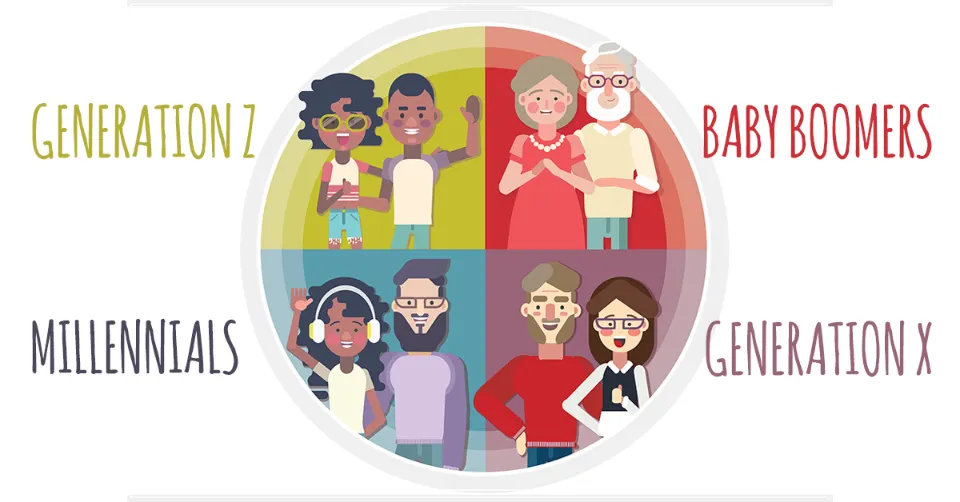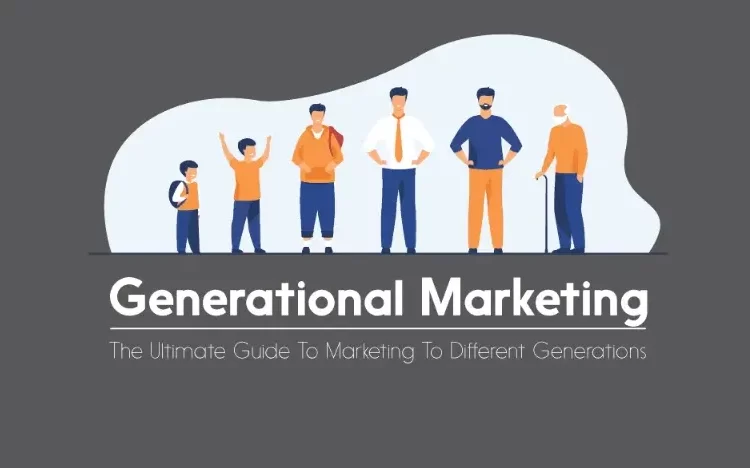Effective marketing strategies attract and engage the right person with the right message at the right time. This is especially true when marketing to people of different generations — known as generational marketing.
When a target audience is segmented and targeted by generation—which is determined by the year they were born—it is known as generational marketing.
Need more information on generational marketing? Keep reading!
Table of Contents
What is Generational Marketing?
In generational marketing, customers are segmented and targeted by generation, determined by the year they were born. As of right now, there are four main generations: baby boomers, generation X (Gen X), millennials, and generation Z (Gen Z). Every generation has its own set of values, tastes, and common experiences that shape the way they think and behave.
Some of their main drivers are cultural and sociopolitical aspects, such as financial instability and technological advancements.
Their mentalities not only characterize them as individuals but also as consumers. For instance, 57% of Generation X say they are still recovering from the Great Recession and are therefore more likely to save for retirement due to financial anxiety than to spend their disposable income. 75% of millennials and Gen Zers, who grew up with modern technology, use smartphones to shop online.
While some people may respond favorably to new innovations, others would rather keep their goods and services the same.
A company’s only factor in deciding how to segment its customers should not be generational marketing. In most cases, additional variables like location, income, and personal preferences enter the picture.
It does, however, offer a solid framework for developing and evaluating personalized marketing campaigns that aids in the development of future strategies that are fully formed.
Read More:
Generational Breakdown

Generational marketing strategies were born when marketers realized that each age group responded to different messages on different channels. Each generation uses social media differently, and some have more brand loyalty than others.
It can be ineffective to try to market to all generations at once. The personalized experience that most consumers expect from a brand may be lost if the messaging is too general and fails to connect. Different messaging that speaks to users where they are, that is, on the channels they use, is more likely to produce positive outcomes.
While this approach is a more effective method, it is necessary to understand how to target each generation effectively.
Silent Generation
Years born: Before 1945
Characteristics: The Silent Generation is the oldest generation to market to. This market is interested in goods and services that facilitate daily living. They value stability because they have loyalty to the companies with which they do business. The people they do business with should be treated with respect and valued.
Marketing strategies: TV, print, radio and direct mail, such as postcards, newsletters and fliers.
Most responsive to: Simple, direct language and imagery that speaks to the target audience. This generation values family, community and respect.
Baby Boomers
Years born: 1946-1964
Characteristics: Baby boomers were born during a period of post-World War II economic expansion. Given their age and time in the workforce, they have the most purchasing power and discretionary income. Although they spent a large portion of their lives without modern technology, baby boomers have embraced it by using social media, mobile devices, and online shopping. They are driven by great deals and are sometimes devoted to the brands from which they purchase.
Marketing strategies: Loyalty programs that encourage in-store purchases and in-person interactions, traditional advertising such as print, radio, and television, and social media as a starting point for brand or product research and convenient online shopping are all examples of traditional advertising.
Most responsive to: customer support and clear, simple, and understandable content.
Generation X
Years born: 1965-1976
Characteristics: The youngest generation, Gen X, was born during a time of economic recession. They are cautious with money and are more skeptical of brands. This generation is wary of innovation and change and would rather hold onto what they are familiar with. Gen Xers respond favorably to sentimentality, word-of-mouth, and customer reviews. Additionally, they have had access to contemporary technology for a significant portion of their lives.
Marketing strategies: Traditional advertising; loyalty programs; email and social media marketing; word-of-mouth; and incentives like sales, gifts, and coupons.
Most responsive to: Clear paths to purchase, clear messaging, email marketing campaigns, customer service, deals, and social media are all examples of this.
Millennials
Years born: 1977-1995
Characteristics: The first generation to grow up with modern technology was the millennial generation, also referred to as Generation Y. Since this generation is the largest in history, businesses must market to a wider demographic in order to attract a sizable customer base. Millennials place importance on authentic brand messaging and seek out brands that support social and environmental causes. This generation relies on user-generated content and the power of word-of-mouth marketing. Instead of price reductions brought on by offers and deals, they prefer brands that offer lower prices.
Marketing strategies: Multichannel, user-generated content, influencer marketing, social media marketing, and content marketing.
Most responsive to: Cause-related brands, social media marketing, customer feedback, trustworthy brands, price-to-value analysis, and digital marketing.
Generation Z
Years born: 1996-present
Characteristics: Gen Z is the most diverse generation and the most tech-savvy. Despite the fact that many members of this generation are still in their youth, they have a sizable amount of purchasing power. Because of the anxiety they feel related to personal debt, Generation Z values financial stability. Compared to other generations, they depend more on social media reviews and endorsements, and they interact with companies that employ social selling strategies. Gen Zers are also less likely to sign up for loyalty programs, despite looking for ways to save money.
Marketing strategies: Influencer marketing, video reviews, social selling, mobile interactions, YouTube, Instagram, Snapchat, and TikTok.
Most responsive to: Short videos, social and economic causes, influencer marketing, smartphone apps, and testimonials.
A Bonus Microgeneration: Xennials
With such a range of years that these generations cover, sometimes, a group of people are caught right in the middle. A microgeneration is produced because there is no clear cut boundary for where someone should fit.
The microgeneration of xennials consists of individuals born in the early millennial or late Gen X time periods. Although this group grew up with technology, social media wasn’t around when they were kids or teenagers. They were also older and more aware of what was going on after 9/11 than most millennials, who were hardly out of their teens.
Additionally, there are distinctive strategies for marketing to millennials because they are financially independent, entrepreneurial, and place a high value on travel.
Years born: 1977-1985
Characteristics: Xennials value time as a luxury. Since many people work long hours, providing customers with mobile and simple-to-use customer experiences is essential.
Although they did not grow up with the internet, they have adapted to it and welcome its use in making decisions about what to buy. Transparency is admired because people can be dubious about the goals or principles of well-established industries.
Marketing strategies: Maintaining content’s relevance and timeliness involves using both digital and traditional marketing strategies, social media advertising, subscription plans, and the revival or reintroduction of previous products.
Most responsive to: Transparency, nostalgia, easy paths to purchase, subscription models, home delivery of big-ticket items, health, and self-care.
Final Thoughts on Generational Marketing
Generational marketing helps you understand the differences and similarities between each generation and how you can better attract the attention of each age group. Even though Gen Z and Millennials are the newest, most technologically advanced generations, you shouldn’t disregard older customers.
Don’t take elderly customers for granted and design campaigns that appeal to them as well. Don’t be misled by outdated stereotypes; older consumers are not as tech-averse and are open to trying new things (or products) as long as they catch their attention.
FAQs
Why is Generational Marketing Important?
Generational marketing helps you understand the differences and similarities between each generation and how you can better attract the attention of each age group.
What Are the Characteristics of Generational Marketing?
In generational marketing, customers are segmented and targeted by generation, determined by the year they were born.
Is Generational Marketing Effective?
The answer is no for extremely targeted marketing. Generalizing your target audience just because they fit within a certain age range or generation isn’t always effective.





